tire type PONTIAC G8 2008 Owners Manual
[x] Cancel search | Manufacturer: PONTIAC, Model Year: 2008, Model line: G8, Model: PONTIAC G8 2008Pages: 334, PDF Size: 2.99 MB
Page 169 of 334
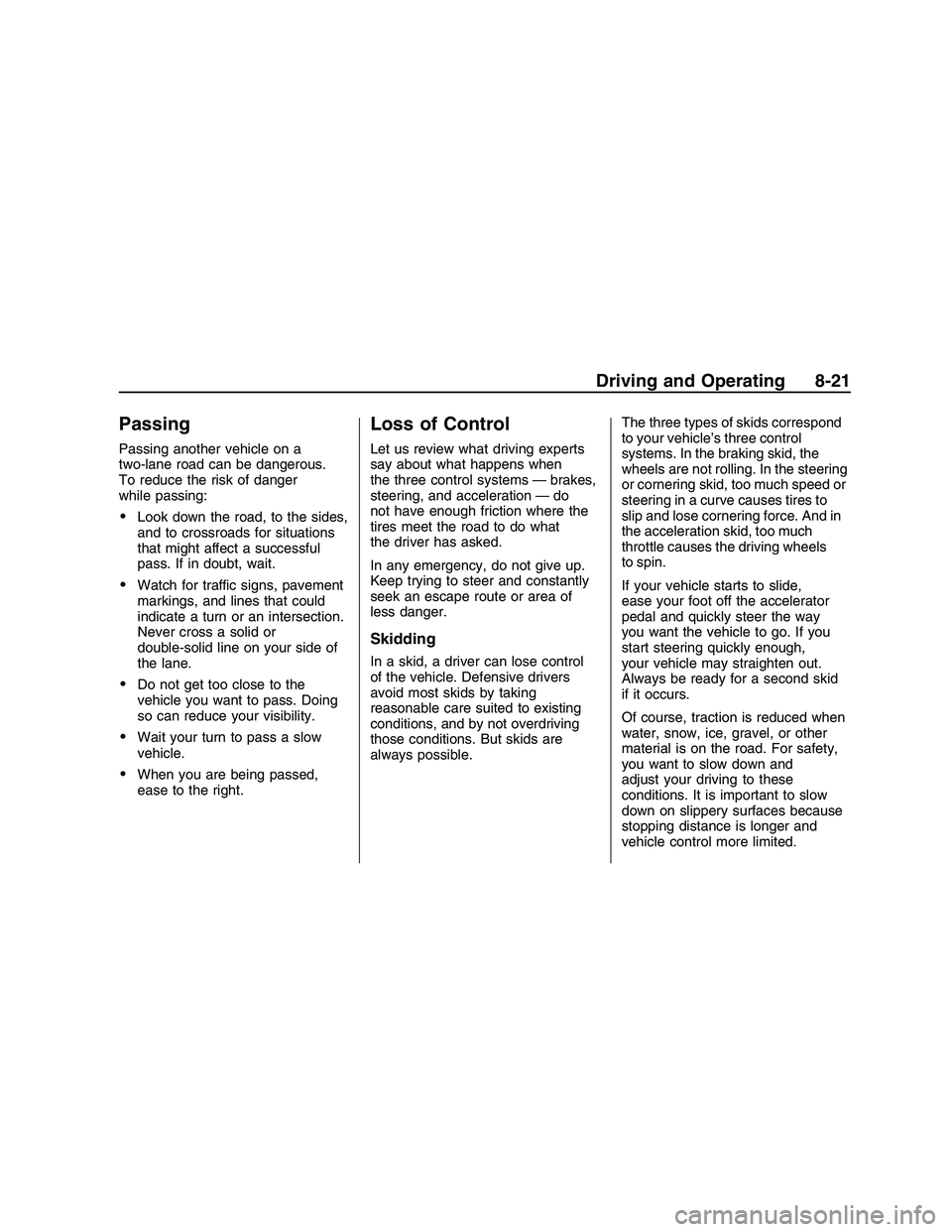
Passing
Passing another vehicle on a
two-lane road can be dangerous.
To reduce the risk of danger
while passing:
Look down the road, to the sides,
and to crossroads for situations
that might affect a successful
pass. If in doubt, wait.
Watch for traffic signs, pavement
markings, and lines that could
indicate a turn or an intersection.
Never cross a solid or
double-solid line on your side of
the lane.
Do not get too close to the
vehicle you want to pass. Doing
so can reduce your visibility.
Wait your turn to pass a slow
vehicle.
When you are being passed,
ease to the right.
Loss of Control
Let us review what driving experts
say about what happens when
the three control systems — brakes,
steering, and acceleration — do
not have enough friction where the
tires meet the road to do what
the driver has asked.
In any emergency, do not give up.
Keep trying to steer and constantly
seek an escape route or area of
less danger.
Skidding
In a skid, a driver can lose control
of the vehicle. Defensive drivers
avoid most skids by taking
reasonable care suited to existing
conditions, and by not overdriving
those conditions. But skids are
always possible.The three types of skids correspond
to your vehicle’s three control
systems. In the braking skid, the
wheels are not rolling. In the steering
or cornering skid, too much speed or
steering in a curve causes tires to
slip and lose cornering force. And in
the acceleration skid, too much
throttle causes the driving wheels
to spin.
If your vehicle starts to slide,
ease your foot off the accelerator
pedal and quickly steer the way
you want the vehicle to go. If you
start steering quickly enough,
your vehicle may straighten out.
Always be ready for a second skid
if it occurs.
Of course, traction is reduced when
water, snow, ice, gravel, or other
material is on the road. For safety,
you want to slow down and
adjust your driving to these
conditions. It is important to slow
down on slippery surfaces because
stopping distance is longer and
vehicle control more limited.
Driving and Operating 8-21
2008 - Pontiac G8 Owner Manual
Page 171 of 334
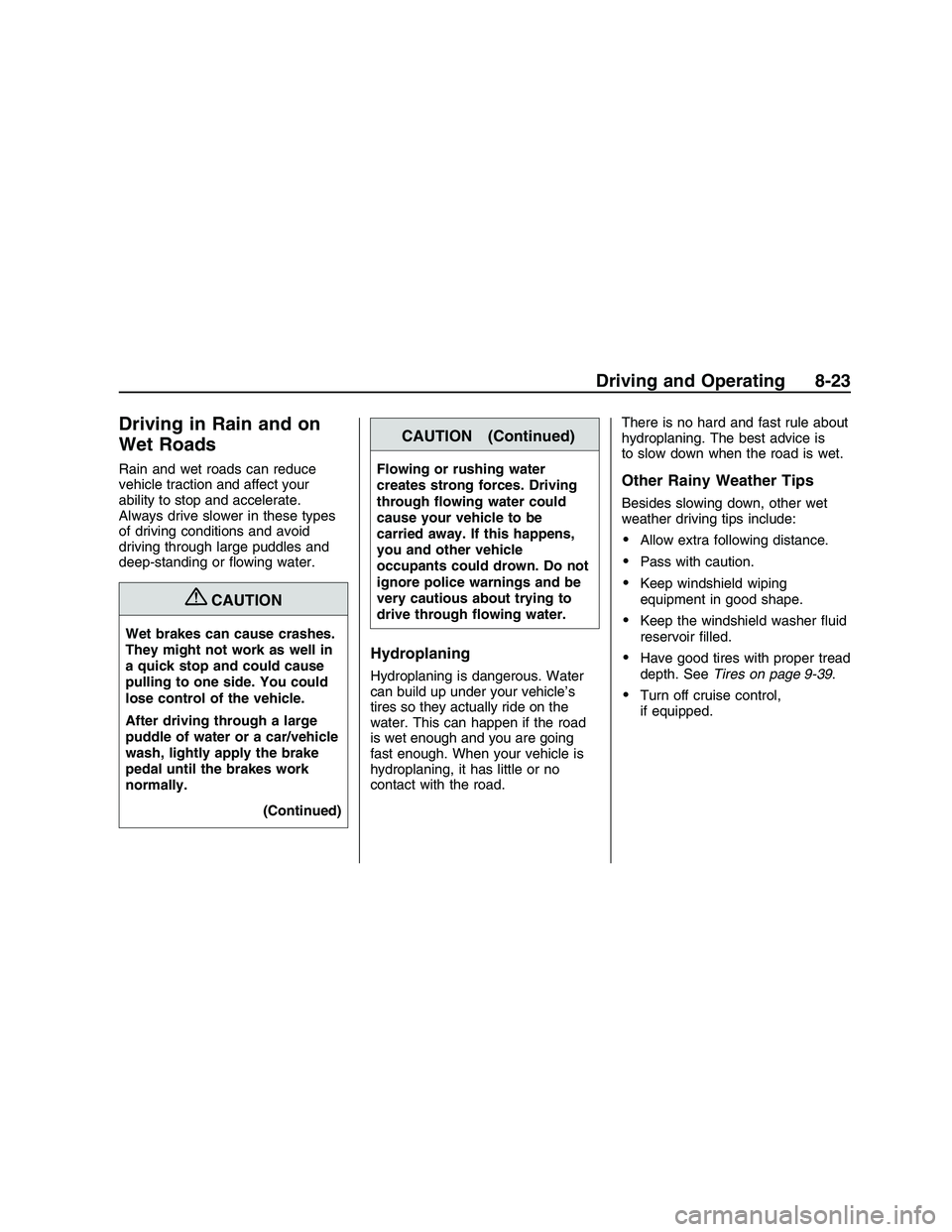
Driving in Rain and on
Wet Roads
Rain and wet roads can reduce
vehicle traction and affect your
ability to stop and accelerate.
Always drive slower in these types
of driving conditions and avoid
driving through large puddles and
deep-standing or �owing water.
{CAUTION
Wet brakes can cause crashes.
They might not work as well in
a quick stop and could cause
pulling to one side. You could
lose control of the vehicle.
After driving through a large
puddle of water or a car/vehicle
wash, lightly apply the brake
pedal until the brakes work
normally.
(Continued)
CAUTION (Continued)
Flowing or rushing water
creates strong forces. Driving
through �owing water could
cause your vehicle to be
carried away. If this happens,
you and other vehicle
occupants could drown. Do not
ignore police warnings and be
very cautious about trying to
drive through �owing water.
Hydroplaning
Hydroplaning is dangerous. Water
can build up under your vehicle’s
tires so they actually ride on the
water. This can happen if the road
is wet enough and you are going
fast enough. When your vehicle is
hydroplaning, it has little or no
contact with the road.There is no hard and fast rule about
hydroplaning. The best advice is
to slow down when the road is wet.
Other Rainy Weather Tips
Besides slowing down, other wet
weather driving tips include:
Allow extra following distance.
Pass with caution.
Keep windshield wiping
equipment in good shape.
Keep the windshield washer �uid
reservoir �lled.
Have good tires with proper tread
depth. SeeTires on page 9-39.
Turn off cruise control,
if equipped.
Driving and Operating 8-23
2008 - Pontiac G8 Owner Manual
Page 224 of 334
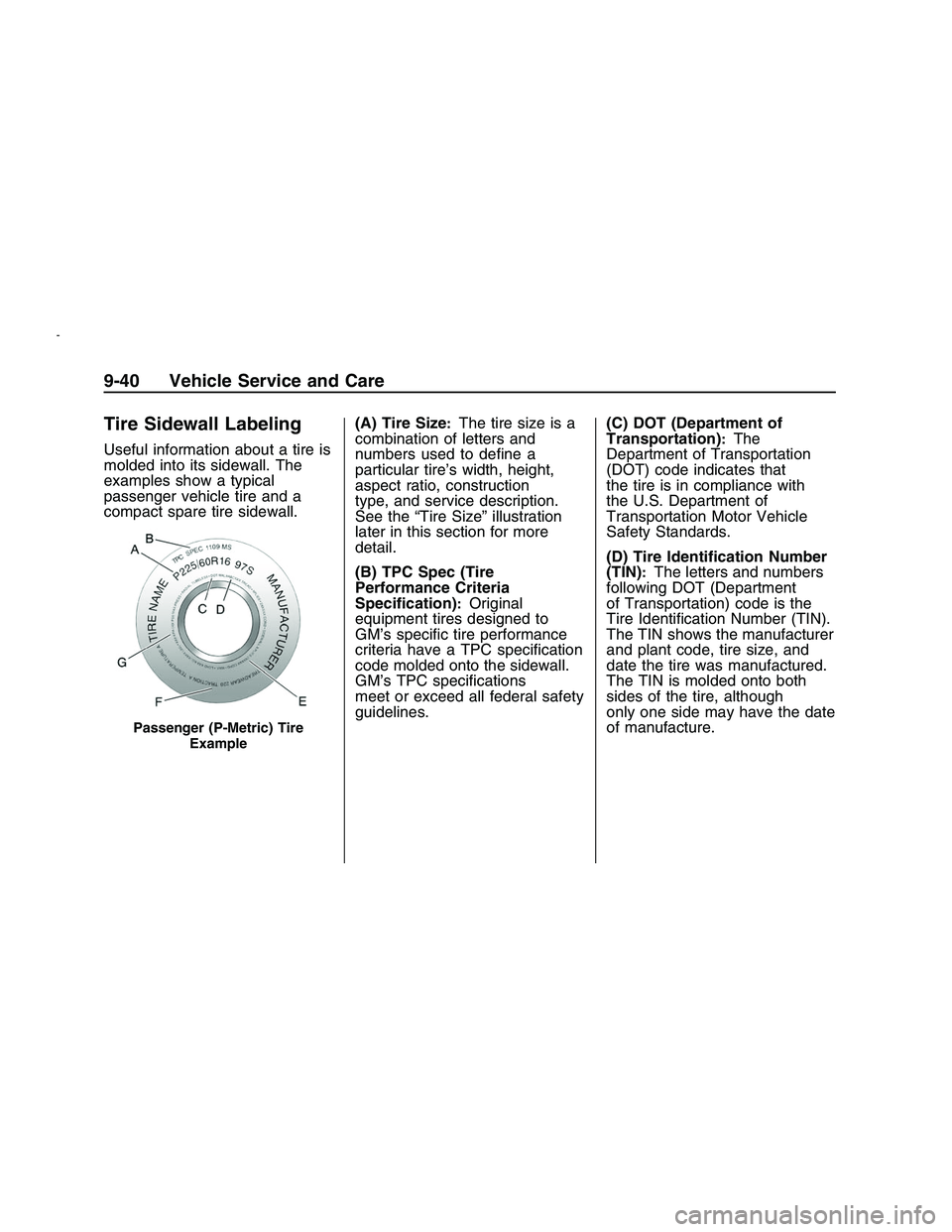
Tire Sidewall Labeling
Useful information about a tire is
molded into its sidewall. The
examples show a typical
passenger vehicle tire and a
compact spare tire sidewall.(A) Tire Size
:The tire size is a
combination of letters and
numbers used to de�ne a
particular tire’s width, height,
aspect ratio, construction
type, and service description.
See the “Tire Size” illustration
later in this section for more
detail.
(B) TPC Spec (Tire
Performance Criteria
Speci�cation)
:Original
equipment tires designed to
GM’s speci�c tire performance
criteria have a TPC speci�cation
code molded onto the sidewall.
GM’s TPC speci�cations
meet or exceed all federal safety
guidelines.(C) DOT (Department of
Transportation)
:The
Department of Transportation
(DOT) code indicates that
the tire is in compliance with
the U.S. Department of
Transportation Motor Vehicle
Safety Standards.
(D) Tire Identi�cation Number
(TIN)
:The letters and numbers
following DOT (Department
of Transportation) code is the
Tire Identi�cation Number (TIN).
The TIN shows the manufacturer
and plant code, tire size, and
date the tire was manufactured.
The TIN is molded onto both
sides of the tire, although
only one side may have the date
of manufacture.
Passenger (P-Metric) Tire
Example
9-40 Vehicle Service and Care
2008 - Pontiac G8 Owner Manual
Page 225 of 334
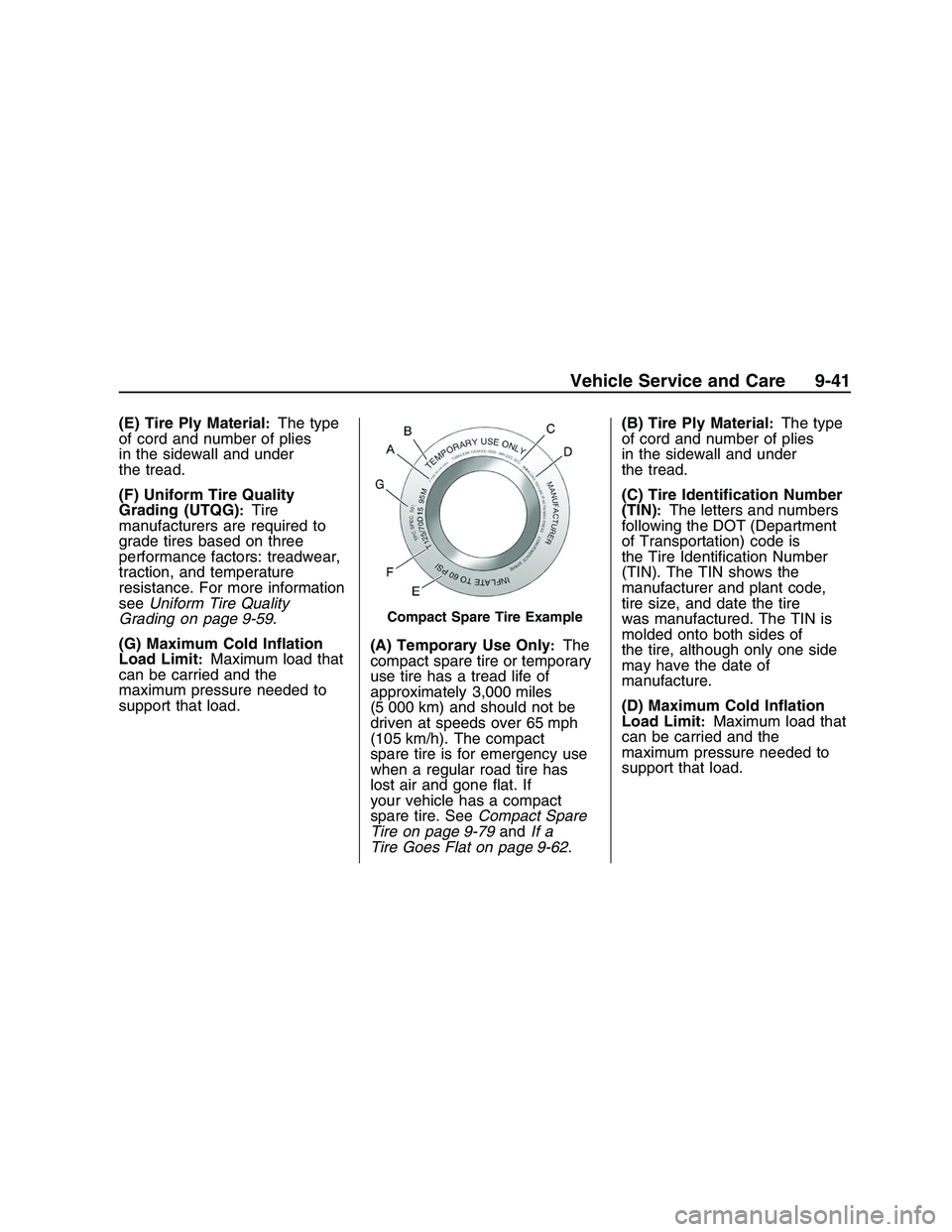
(E) Tire Ply Material:The type
of cord and number of plies
in the sidewall and under
the tread.
(F) Uniform Tire Quality
Grading (UTQG)
:Tire
manufacturers are required to
grade tires based on three
performance factors: treadwear,
traction, and temperature
resistance. For more information
seeUniform Tire Quality
Grading on page 9-59.
(G) Maximum Cold In�ation
Load Limit
:Maximum load that
can be carried and the
maximum pressure needed to
support that load.(A) Temporary Use Only:The
compact spare tire or temporary
use tire has a tread life of
approximately 3,000 miles
(5 000 km) and should not be
driven at speeds over 65 mph
(105 km/h). The compact
spare tire is for emergency use
when a regular road tire has
lost air and gone �at. If
your vehicle has a compact
spare tire. SeeCompact Spare
Tire on page 9-79andIf a
Tire Goes Flat on page 9-62.(B) Tire Ply Material
:The type
of cord and number of plies
in the sidewall and under
the tread.
(C) Tire Identi�cation Number
(TIN)
:The letters and numbers
following the DOT (Department
of Transportation) code is
the Tire Identi�cation Number
(TIN). The TIN shows the
manufacturer and plant code,
tire size, and date the tire
was manufactured. The TIN is
molded onto both sides of
the tire, although only one side
may have the date of
manufacture.
(D) Maximum Cold In�ation
Load Limit
:Maximum load that
can be carried and the
maximum pressure needed to
support that load.
Compact Spare Tire Example
Vehicle Service and Care 9-41
2008 - Pontiac G8 Owner Manual
Page 226 of 334
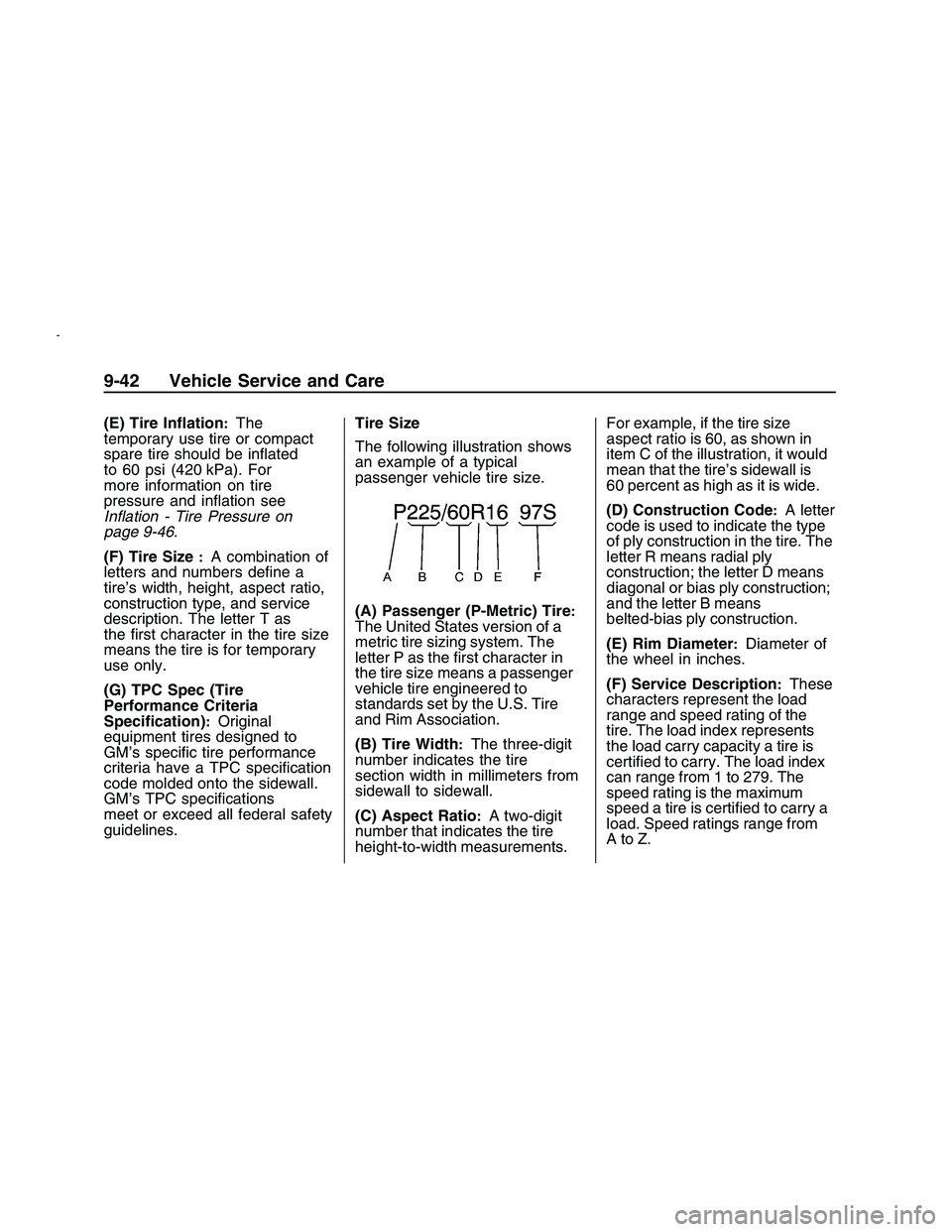
(E) Tire In�ation:The
temporary use tire or compact
spare tire should be in�ated
to 60 psi (420 kPa). For
more information on tire
pressure and in�ation see
Inflation - Tire Pressure on
page 9-46.
(F) Tire Size
:A combination of
letters and numbers de�ne a
tire’s width, height, aspect ratio,
construction type, and service
description. The letter T as
the �rst character in the tire size
means the tire is for temporary
use only.
(G) TPC Spec (Tire
Performance Criteria
Speci�cation)
:Original
equipment tires designed to
GM’s speci�c tire performance
criteria have a TPC speci�cation
code molded onto the sidewall.
GM’s TPC speci�cations
meet or exceed all federal safety
guidelines.Tire Size
The following illustration shows
an example of a typical
passenger vehicle tire size.
(A) Passenger (P-Metric) Tire
:The United States version of a
metric tire sizing system. The
letter P as the �rst character in
the tire size means a passenger
vehicle tire engineered to
standards set by the U.S. Tire
and Rim Association.
(B) Tire Width
:The three-digit
number indicates the tire
section width in millimeters from
sidewall to sidewall.
(C) Aspect Ratio
:A two-digit
number that indicates the tire
height-to-width measurements.For example, if the tire size
aspect ratio is 60, as shown in
item C of the illustration, it would
mean that the tire’s sidewall is
60 percent as high as it is wide.
(D) Construction Code
:A letter
code is used to indicate the type
of ply construction in the tire. The
letter R means radial ply
construction; the letter D means
diagonal or bias ply construction;
and the letter B means
belted-bias ply construction.
(E) Rim Diameter
:Diameter of
the wheel in inches.
(F) Service Description
:These
characters represent the load
range and speed rating of the
tire. The load index represents
the load carry capacity a tire is
certi�ed to carry. The load index
can range from 1 to 279. The
speed rating is the maximum
speed a tire is certi�ed to carry a
load. Speed ratings range from
AtoZ.
9-42 Vehicle Service and Care
2008 - Pontiac G8 Owner Manual
Page 231 of 334
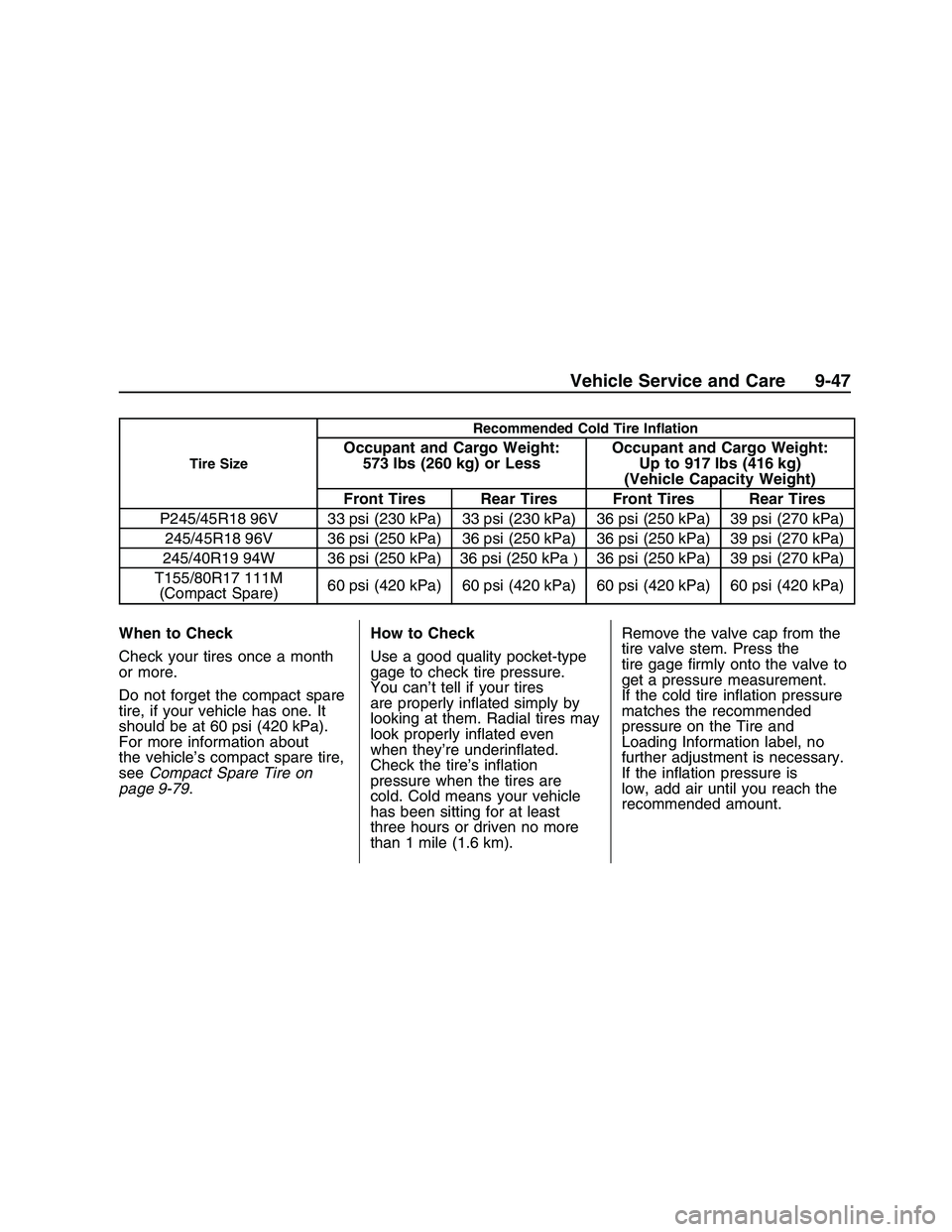
Tire SizeRecommended Cold Tire In�ationOccupant and Cargo Weight:
573 lbs (260 kg) or Less Occupant and Cargo Weight:
Up to 917 lbs (416 kg)
(Vehicle Capacity Weight)
Front Tires Rear Tires Front Tires Rear Tires
P245/45R18 96V 33 psi (230 kPa) 33 psi (230 kPa) 36 psi (250 kPa) 39 psi (270 kPa) 245/45R18 96V 36 psi (250 kPa) 36 psi (250 kPa) 36 psi (250 kPa) 39 psi (270 kPa)
245/40R19 94W 36 psi (250 kPa) 36 psi (250 kPa
)36 psi (250 kPa) 39 psi (270 kPa)
T155/80R17 111M (Compact Spare) 60 psi (420 kPa) 60 psi (420 kPa) 60 psi (420 kPa) 60 psi (420 kPa)
When to Check
Check your tires once a month
or more.
Do not forget the compact spare
tire, if your vehicle has one. It
should be at 60 psi (420 kPa).
For more information about
the vehicle’s compact spare tire,
see Compact Spare Tire on
page 9-79 . How to Check
Use a good quality pocket-type
gage to check tire pressure.
You can’t tell if your tires
are properly in�ated simply by
looking at them. Radial tires may
look properly in�ated even
when they’re underin�ated.
Check the tire’s in�ation
pressure when the tires are
cold. Cold means your vehicle
has been sitting for at least
three hours or driven no more
than 1 mile (1.6 km). Remove the valve cap from the
tire valve stem. Press the
tire gage �rmly onto the valve to
get a pressure measurement.
If the cold tire in�ation pressure
matches the recommended
pressure on the Tire and
Loading Information label, no
further adjustment is necessary.
If the in�ation pressure is
low, add air until you reach the
recommended amount.
Vehicle Service and Care 9-47
2008 - Pontiac G8 Owner Manual
Page 241 of 334
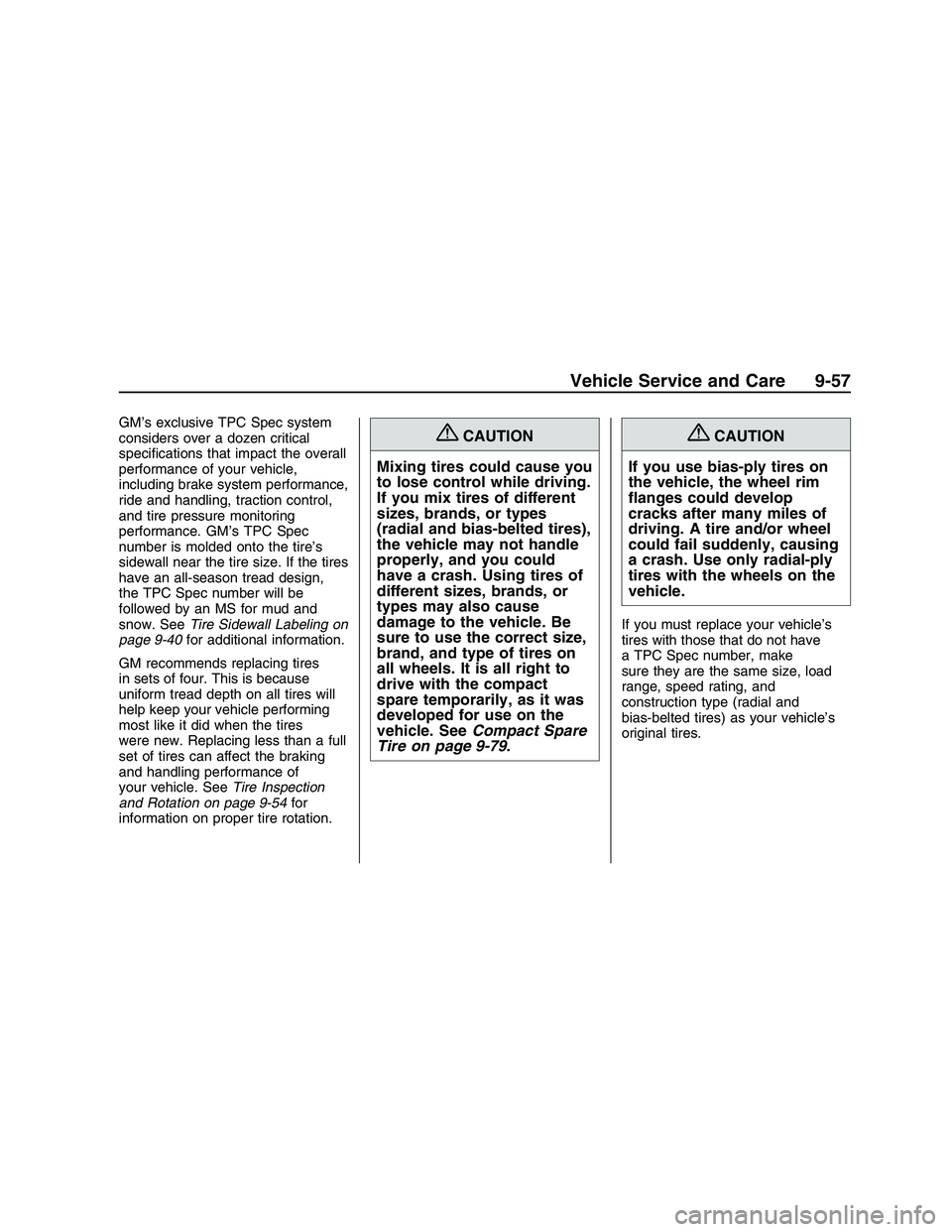
GM’s exclusive TPC Spec system
considers over a dozen critical
speci�cations that impact the overall
performance of your vehicle,
including brake system performance,
ride and handling, traction control,
and tire pressure monitoring
performance. GM’s TPC Spec
number is molded onto the tire’s
sidewall near the tire size. If the tires
have an all-season tread design,
the TPC Spec number will be
followed by an MS for mud and
snow. SeeTire Sidewall Labeling on
page 9-40for additional information.
GM recommends replacing tires
in sets of four. This is because
uniform tread depth on all tires will
help keep your vehicle performing
most like it did when the tires
were new. Replacing less than a full
set of tires can affect the braking
and handling performance of
your vehicle. SeeTire Inspection
and Rotation on page 9-54for
information on proper tire rotation.{CAUTION
Mixing tires could cause you
to lose control while driving.
If you mix tires of different
sizes, brands, or types
(radial and bias-belted tires),
the vehicle may not handle
properly, and you could
have a crash. Using tires of
different sizes, brands, or
types may also cause
damage to the vehicle. Be
sure to use the correct size,
brand, and type of tires on
all wheels. It is all right to
drive with the compact
spare temporarily, as it was
developed for use on the
vehicle. SeeCompact Spare
Tire on page 9-79.{CAUTION
If you use bias-ply tires on
the vehicle, the wheel rim
�anges could develop
cracks after many miles of
driving. A tire and/or wheel
could fail suddenly, causing
a crash. Use only radial-ply
tires with the wheels on the
vehicle.
If you must replace your vehicle’s
tires with those that do not have
a TPC Spec number, make
sure they are the same size, load
range, speed rating, and
construction type (radial and
bias-belted tires) as your vehicle’s
original tires.
Vehicle Service and Care 9-57
2008 - Pontiac G8 Owner Manual
Page 243 of 334
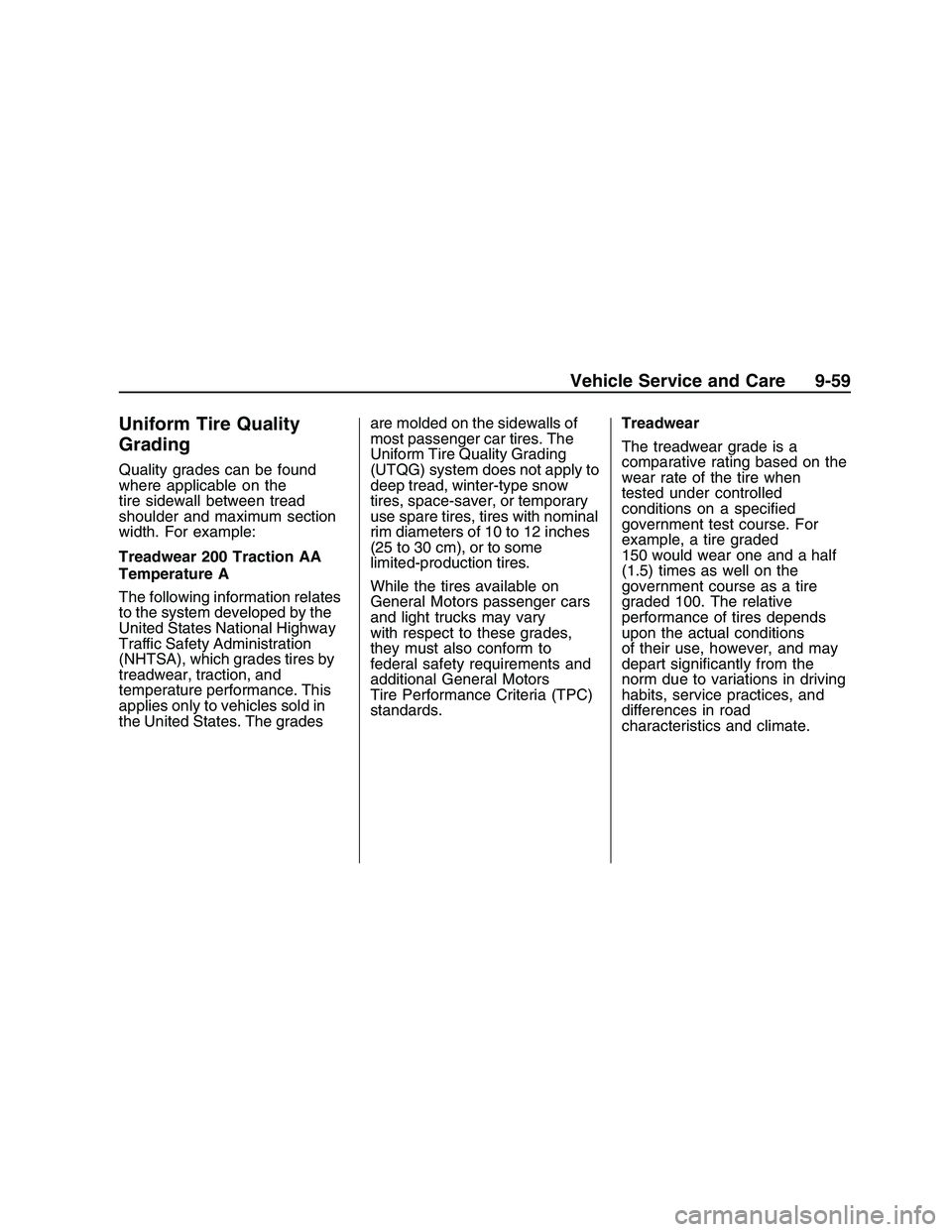
Uniform Tire Quality
Grading
Quality grades can be found
where applicable on the
tire sidewall between tread
shoulder and maximum section
width. For example:
Treadwear 200 Traction AA
Temperature A
The following information relates
to the system developed by the
United States National Highway
Traffic Safety Administration
(NHTSA), which grades tires by
treadwear, traction, and
temperature performance. This
applies only to vehicles sold in
the United States. The gradesare molded on the sidewalls of
most passenger car tires. The
Uniform Tire Quality Grading
(UTQG) system does not apply to
deep tread, winter-type snow
tires, space-saver, or temporary
use spare tires, tires with nominal
rim diameters of 10 to 12 inches
(25 to 30 cm), or to some
limited-production tires.
While the tires available on
General Motors passenger cars
and light trucks may vary
with respect to these grades,
they must also conform to
federal safety requirements and
additional General Motors
Tire Performance Criteria (TPC)
standards.Treadwear
The treadwear grade is a
comparative rating based on the
wear rate of the tire when
tested under controlled
conditions on a speci�ed
government test course. For
example, a tire graded
150 would wear one and a half
(1.5) times as well on the
government course as a tire
graded 100. The relative
performance of tires depends
upon the actual conditions
of their use, however, and may
depart signi�cantly from the
norm due to variations in driving
habits, service practices, and
differences in road
characteristics and climate.
Vehicle Service and Care 9-59
2008 - Pontiac G8 Owner Manual
Page 246 of 334
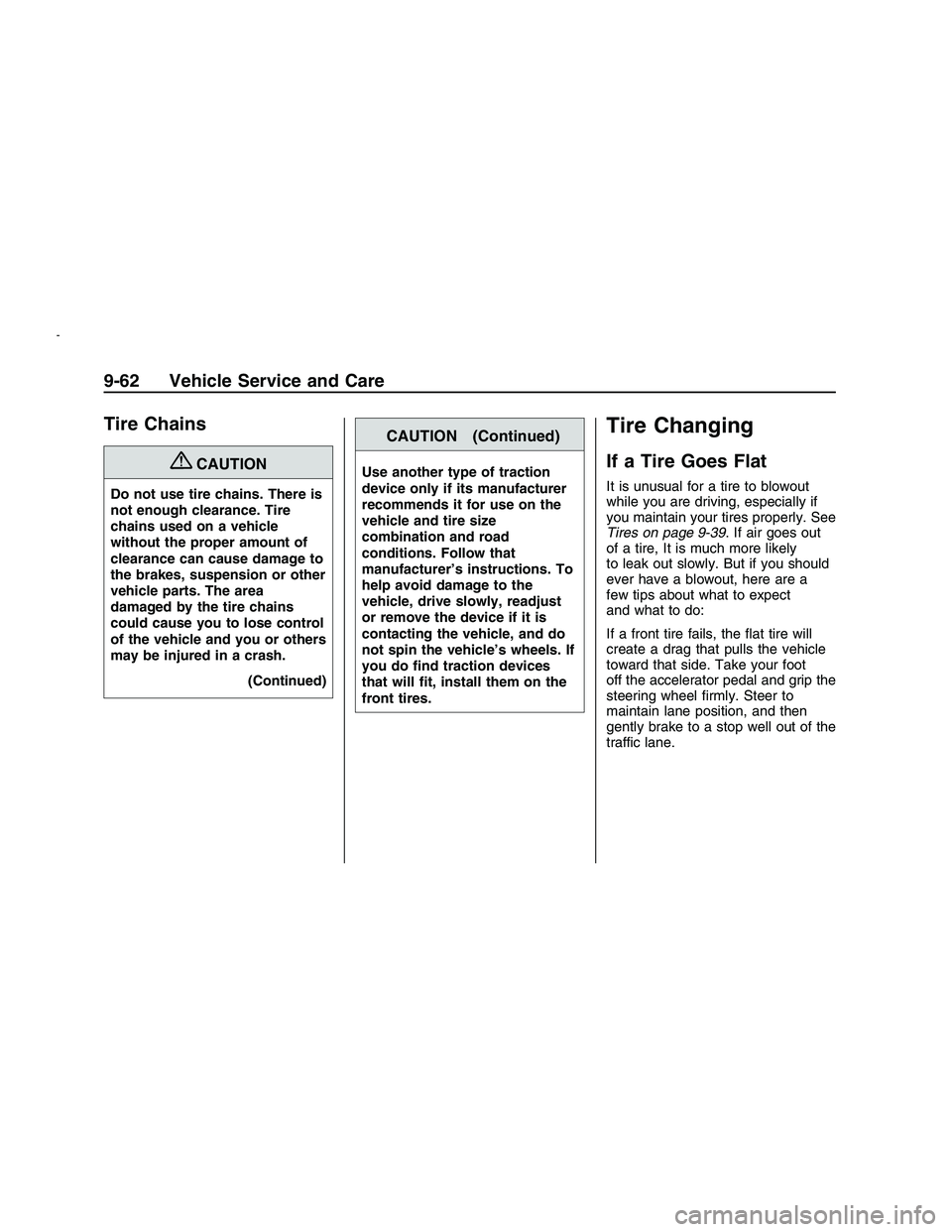
Tire Chains
{CAUTION
Do not use tire chains. There is
not enough clearance. Tire
chains used on a vehicle
without the proper amount of
clearance can cause damage to
the brakes, suspension or other
vehicle parts. The area
damaged by the tire chains
could cause you to lose control
of the vehicle and you or others
may be injured in a crash.
(Continued)
CAUTION (Continued)
Use another type of traction
device only if its manufacturer
recommends it for use on the
vehicle and tire size
combination and road
conditions. Follow that
manufacturer’s instructions. To
help avoid damage to the
vehicle, drive slowly, readjust
or remove the device if it is
contacting the vehicle, and do
not spin the vehicle’s wheels. If
you do �nd traction devices
that will �t, install them on the
front tires.
Tire Changing
If a Tire Goes Flat
It is unusual for a tire to blowout
while you are driving, especially if
you maintain your tires properly. See
Tires on page 9-39. If air goes out
of a tire, It is much more likely
to leak out slowly. But if you should
ever have a blowout, here are a
few tips about what to expect
and what to do:
If a front tire fails, the �at tire will
create a drag that pulls the vehicle
toward that side. Take your foot
off the accelerator pedal and grip the
steering wheel �rmly. Steer to
maintain lane position, and then
gently brake to a stop well out of the
traffic lane.
9-62 Vehicle Service and Care
2008 - Pontiac G8 Owner Manual
Page 272 of 334
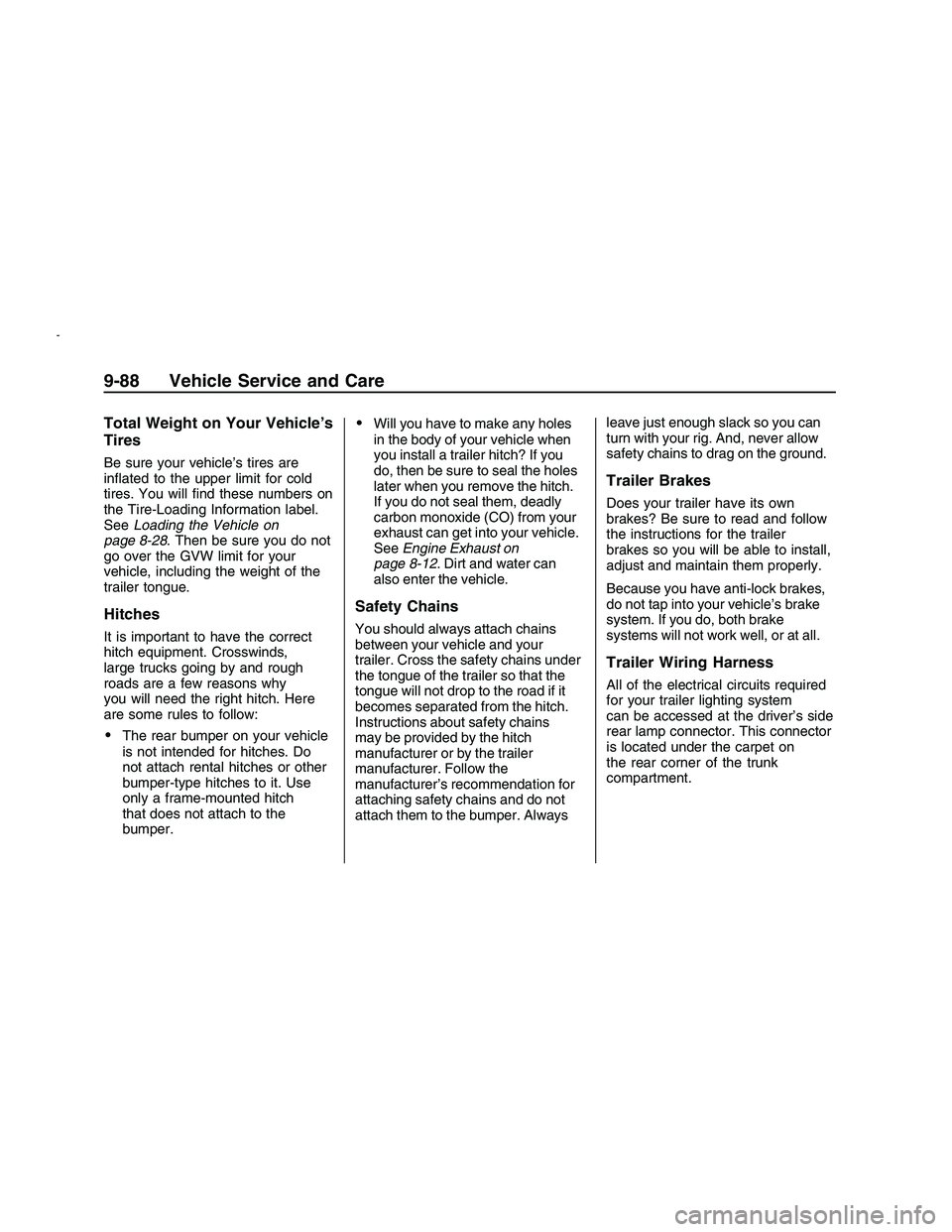
Total Weight on Your Vehicle’s
Tires
Be sure your vehicle’s tires are
in�ated to the upper limit for cold
tires. You will �nd these numbers on
the Tire-Loading Information label.
SeeLoading the Vehicle on
page 8-28. Then be sure you do not
go over the GVW limit for your
vehicle, including the weight of the
trailer tongue.
Hitches
It is important to have the correct
hitch equipment. Crosswinds,
large trucks going by and rough
roads are a few reasons why
you will need the right hitch. Here
are some rules to follow:
The rear bumper on your vehicle
is not intended for hitches. Do
not attach rental hitches or other
bumper-type hitches to it. Use
only a frame-mounted hitch
that does not attach to the
bumper.
Will you have to make any holes
in the body of your vehicle when
you install a trailer hitch? If you
do, then be sure to seal the holes
later when you remove the hitch.
If you do not seal them, deadly
carbon monoxide (CO) from your
exhaust can get into your vehicle.
SeeEngine Exhaust on
page 8-12. Dirt and water can
also enter the vehicle.
Safety Chains
You should always attach chains
between your vehicle and your
trailer. Cross the safety chains under
the tongue of the trailer so that the
tongue will not drop to the road if it
becomes separated from the hitch.
Instructions about safety chains
may be provided by the hitch
manufacturer or by the trailer
manufacturer. Follow the
manufacturer’s recommendation for
attaching safety chains and do not
attach them to the bumper. Alwaysleave just enough slack so you can
turn with your rig. And, never allow
safety chains to drag on the ground.
Trailer Brakes
Does your trailer have its own
brakes? Be sure to read and follow
the instructions for the trailer
brakes so you will be able to install,
adjust and maintain them properly.
Because you have anti-lock brakes,
do not tap into your vehicle’s brake
system. If you do, both brake
systems will not work well, or at all.
Trailer Wiring Harness
All of the electrical circuits required
for your trailer lighting system
can be accessed at the driver’s side
rear lamp connector. This connector
is located under the carpet on
the rear corner of the trunk
compartment.
9-88 Vehicle Service and Care
2008 - Pontiac G8 Owner Manual